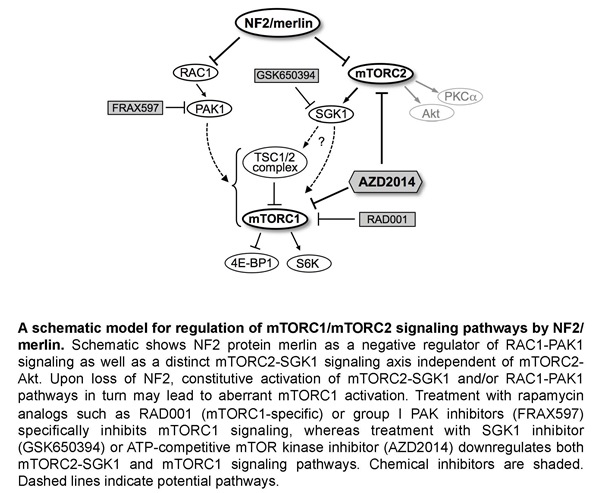Neurofibromatosis
Finding New Targets for Treatment of NF2-Deficient Meningiomas



Posted June 14, 2016
Vijaya Ramesh, Ph.D., Massachusetts General Hospital
 Neurofibromatosis 2, or NF2, causes growth of different types of tumors in the nervous system, including meningiomas. The current treatments for NF2-related meningiomas are surgical resection (unless the tumor is inoperable) and radiation. There is a need for effective and noninvasive therapy options in the NF2 community. Further, the majority of non-NF2-associated meningiomas are shown to involve loss of the NF2 tumor suppressor gene (which encodes the protein merlin), indicating a common pathway that could be targeted for treatment. Previous data from Dr. Ramesh's laboratory had indicated that merlin functioned to shut off signaling through a group of other proteins, the mammalian target of rapamycin complex 1 (mTORC1) in meningiomas. Without merlin, mTORC1 was always turned on, and its signaling could drive tumor growth; however, treatment with rapamycin, a drug that targets mTORC1, was able to inhibit meningioma growth. These findings laid the groundwork for the rationale behind clinical trials with the mTORC1 inhibitor, everolimus (RAD001).
Neurofibromatosis 2, or NF2, causes growth of different types of tumors in the nervous system, including meningiomas. The current treatments for NF2-related meningiomas are surgical resection (unless the tumor is inoperable) and radiation. There is a need for effective and noninvasive therapy options in the NF2 community. Further, the majority of non-NF2-associated meningiomas are shown to involve loss of the NF2 tumor suppressor gene (which encodes the protein merlin), indicating a common pathway that could be targeted for treatment. Previous data from Dr. Ramesh's laboratory had indicated that merlin functioned to shut off signaling through a group of other proteins, the mammalian target of rapamycin complex 1 (mTORC1) in meningiomas. Without merlin, mTORC1 was always turned on, and its signaling could drive tumor growth; however, treatment with rapamycin, a drug that targets mTORC1, was able to inhibit meningioma growth. These findings laid the groundwork for the rationale behind clinical trials with the mTORC1 inhibitor, everolimus (RAD001).
With a Fiscal Year 2010 (FY10) award from the Neurofibromatosis Research Program (NFRP), Dr. Ramesh and her colleagues performed a high-throughput kinome screen in an effort to understand the mechanism behind the activation of mTORC1 due to loss of merlin. They used meningioma cells deficient in the NF2 gene and silenced various kinases using RNAi technology to determine which were playing a role in mTORC1 signaling. Interestingly, they found that serum/glucocorticoid-regulated kinase 1 (SGK1), a target of mTORC2 (a protein complex related to mTORC1), and p21 protein-activated kinase 1 (PAK1) were mediating the activation of mTORC1 in these cells. The Ramesh lab, through research funded with the NFRP award, had previously reported that suppression of NF2 expression in human arachnoidal cells (cell of origin for meningiomas), led to increased activation of SGK1. In the kinome study, they demonstrated that signaling through mTORC2/SGK1 and PAK1 independently led to activation of mTORC1.
To further examine the role of these kinases in meningioma growth, they performed experiments with inhibitors of these kinases on meningioma cells. The PAK inhibitor, FRAX597, required very high concentrations to prevent cell growth. Rapamycin, the mTORC1 inhibitor, was not very effective at preventing cell growth, whereas treatment with AZD2014, a compound that inhibits both mTORC1 and mTORC2, was quite effective. These results provide evidence that dual mTORC1/mTORC2 inhibitors, such as AZD2014, may be useful therapeutic options for treating meningiomas, and has helped to inform future clinical trials.

Publications:
James MF, Han S, Polizzano C, Plotkin SR, Manning BD, Stemmer-Rachamimov AO, Gusella JF, and Ramesh V. 2009. NF2/Merlin is a novel negative regulator of mTOR complex 1 and activation of mTORC1 is associated with meningioma and schwannoma growth. Mol Cell Biol 29:4250-4261.
Karajannis MA, Legault G, Hagiwara M, Giancotti FG, Filatov A, Derman A, Hochman T, Goldberg JD, Vega E, Wisoff JH, Golfinos JG, Merkelson A, Roland JT, and Allen JC. 2014. Phase II study of everolimus in children and adults with neurofibromatosis type 2 and progressive vestibular schwannomas. Neuro Oncol 16:292-297.
Goutagny S, Raymond E, Esposito-Farese M, Trunet S, Mawrin C, Bernardeschi D, Larroque B, Sterkers O, Giovannini M, and Kalamarides M. 2015. Phase II study of mTORC1 inhibition by everolimus in neurofibromatosis type 2 patients with growing vestibular schwannomas. J neurooncol 122:313-320.
Beauchamp RL, James MF, DeSouza PA, Wagh V, Zhao W-N, Stemmer-Rachamimov A, Plotkin SR, Gusella JF, Haggarty SJ, and Ramesh V. 2015. A high-throughput kinome screen reveals serum/glucocorticoid-regulated kinase 1 as a therapeutic target for NF2-deficient meningiomas. Oncotarget 6(19):16981-16997.
James MF, Stivison E, Beauchamp R, Han S, Li H, Wallace MR, Gusella JF, Stemmer-Rachamimov AO, and Ramesh V. 2012. Regulation of mTOR complex 2 signaling in Neurofibromatosis 2-deficient target cell types. Mol Cancer Res 10:649-659.
Links:
Public and Technical Abstracts: Role of Merlin/NF2 in mTOR Signaling and Meningioma Growth
Last updated Friday, December 13, 2024














